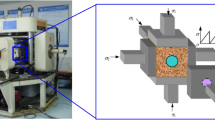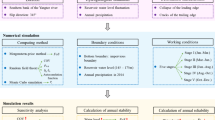Abstract
Risk calculation of levee in the complex environment has significant theoretical values and practical meanings. As there still exists problems in present risk calculation models, a simple and efficient calculation model of the comprehensive levee risk is needed to be established. This paper studies the comprehensive risk calculation model of levee with multiple failure modes based on the analysis of levee instability and seepage failure. Firstly, coupling calculation of the seepage field and stress field is made using the finite element method, and safety factor of levee slope and critical failure hydraulic gradient of levee foundation are determined according to the strength reduction and piping theory. Then, particle swarm optimization is applied to conduct a comparative study on potential impact factors of levee stability and seepage, thus to determine explicit expressions for instability of levee body and seepage failure of levee foundation. Finally, Monte Carlo method is introduced to simulate the levee structure stochastically and calculated the comprehensive levee risk. Calculation results of the example show that the risk calculation method proposed in this paper has higher computational efficiency and can provide references for the decision of levee reinforcement.

















Similar content being viewed by others
References
Baecher GB, Christian JT (2003) Reliability and statistics in geotechnical engineering. Wiley, London
Balas CE, Ergin A (2002) Reliability-based risk assessment in coastal projects: case study in Turkey. J Waterw Port Coast Ocean Eng ASCE 128(2):52–61
Basser H, Karami H, Shamshirband S (2015) Hybrid ANFIS-PSO approach for predicting optimum parameters of a protective spur dike. Appl Soft Comput J 30:642–649
Benjasupattananan S (2013) Deterministic and probabilistic approaches for modeling levee underseepage. Dissertations and theses—gradworks
Bogardi JJ (1974) Determination of the degree of protection offered by flood control systems on the basis of distribution functions. In: Mathematical models in hydrology: proceedings of the Warsaw Symposium, pp. 246–252
Bogdanowicz E, Strupczewski WG, Kochanek K, Markiewicz I (2014) Flood risk for embanked rivers. J Geosci Environ Prot 2(3):135–143
Gao Y, Zhang J (2011) Influencing factors analysis for failure risk of upstream revetment of existing levees. Adv Mater Res 250–253:2843–2847
Guang-Ming XU, Gao CS, Ling Z, Yang SH (2005) Preliminary study of stability of levee on soft ground. Chin J Rock Mech Eng 24(13):2315–2321
Ji Z, Li N, Xie W, Wu J, Zhou Y (2013) Comprehensive assessment of flood risk using the classification and regression tree method. Stoch Env Res Risk Assess 27(8):1815–1828
Jinyu L, Qing Y, Maotian L (2010) Limit equilibrium analysis of the influence of matric suction on unsaturated soil slope stability. J Converg Inf Technol 5(10):167–175
Johnson PA (1996) Uncertainty of hydraulic parameters. J Hydraul Eng ASCE 122(2):112–114
Lázaro JM, Navarro JÁS, Gil AG, Romero VE, Mateo JC (2016) Modelling and layout of drainage-levee devices in river sections. Eng Geol 214:11–19
Liu J, Zhang S (2002) Theory and simulation of fluid–solid coupling flow through low permeability fractured oil reservoir. Acta Mech Sin 34(5):779–784
Liu J, Xie D, Cui Y (2008) Failure mechanism of seepage in levees with double-layer foundation. J Hydraul Eng 39(11):1211–1220
Liu C, Ding L, Sun D (2012) Model test and numerical analysis of piping erosion process in single-stratum dike foundations. China Civ Eng J 45(8):140–147
Orlandini S, Moretti G, Albertson JD (2015) Evidence of an emerging levee failure mechanism causing disastrous floods in italy. Water Resour Res 51(10):7995–8011
Polanco L, Rice J (2014) A reliability-based evaluation of the effects of geometry on levee under seepage potential. Geotech Geol Eng 32(4):807–820
Reinert E, Stewart JP (2014) Dynamic response of a model levee on Sherman island peat: a curated data set. Earthq Spectra 30(2):639–656
Rice JD, Polanco L (2012) Reliability-based under seepage analysis in levees using a response surface-Monte Carlo simulation method. J Geotech Geoenviron Eng 138(7):821–830
Thangaraj R (2012) Modified particle swarm optimization with time varying velocity vector. Int J Innov Comput Inf Control 1A:201–218
Vijiling JK (1998) Probabilistic design of water defense system in The Netherlands. Reliab Eng Syst Saf 71(2):141–150
Wang Z, Yang G (1998) Risk calculation model for flood levee structure. J Hydraul Eng 07:64–67
Wu X, Ding L, Zhang J (2003) Study on reliability design method of flood defenses. J Hydraul Eng 4:99
Wu SJ, Lien HC, Chang CH (2010) Modeling risk analysis for forecasting peak discharge during flooding prevention and warning operation. Stoch Env Res Risk Assess 24(8):1175–1191
Yang B, Chen Y, Wei S (2013) The fluid–solid coupling analysis of three-dimensional slope based on ABAQUS. Appl Mech Mater 353–354:663–668
Yeou-Koung T, Mays LW (1981) Risk models for flood levee design. Water Resour Res 17(4):833–841
Zhang X, Dai Z (2010) Analysis of slope stability under seepage by using ABAQUS program. Chin J Rock Mech Eng 29(Suppl 1):2927–2934
Zhou X, Jie Y, Li G (2011) Numerical simulation of piping in levee. J Hydroelectr Eng 30(2):100–106
Acknowledgements
This research has been partially supported by National Natural Science Foundation of China (SN: 51579083, 51479054, 41323001), the National Key Research and Development Program of China (SN: 2016YFC0401601), the Doctoral Program of Higher Education of China (SN: 20130094110010), Open Foundation of State Key Laboratory of Hydrology-Water Resources and Hydraulic Engineering (SN: 20165042112, 20145027612), the Fundamental Research Funds for the Central Universities (Grant No. 2015B25414).
Author information
Authors and Affiliations
Corresponding author
Rights and permissions
About this article
Cite this article
Fu, Z., Su, H., Han, Z. et al. Multiple failure modes-based practical calculation model on comprehensive risk for levee structure. Stoch Environ Res Risk Assess 32, 1051–1064 (2018). https://doi.org/10.1007/s00477-017-1448-2
Published:
Issue Date:
DOI: https://doi.org/10.1007/s00477-017-1448-2




